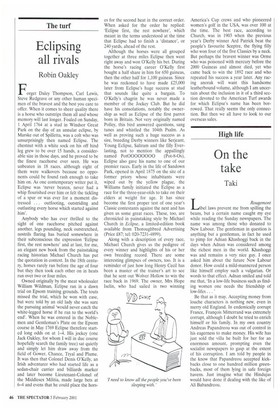Eclipsing all rivals
Robin Oakley
Forget Daley Thompson, Carl Lewis, Steve Redgrave or any other human specimen of the bravest and the best you care to offer. When it comes to sheer quality there is a horse who outstrips them all and whose memory will last longer. Foaled on Sunday, 1 April 1764 at a stud in Windsor Great Park on the day of an annular eclipse, by Marske out of Spilletta, was a colt who was unsurprisingly then named Eclipse. The chestnut with a white sock on his off hind leg grew to be over 15 hands, a considerable size in those days, and he proved to be the finest racehorse ever seen. He was unbeaten in 18 races, although eight of them were walkovers because no opponents could be found rash enough to take him on. As one contemporary writer put it, Eclipse was 'never beaten, never had a whip flourished over him or felt the tickling of a spur or was ever for a moment distressed . . . outfooting, outstriding and outlasting every horse which started against him'.
Anybody who has ever thrilled to the sight of one racehorse pitched against another, legs pounding, neck outstretched, nostrils flaring has buried somewhere in their subconscious the expression 'Eclipse first, the rest nowhere' and at last, for me, an elegant new book from the painstaking racing historian Michael Church has put the quotation in context. In the 18th century, horses rarely ran before the age of four but they then took each other on in heats run over two or four miles.
Owned originally by the meat wholesaler William Wildman, Eclipse ran in a dawn trial on Epsom training grounds. The touts missed the trial, which he won with ease, but were told by an old lady she was sure the pursuing animal 'would never-catch the white-legged horse if he ran to the world's end-. When he was entered in the Noblemen and Gentleman's Plate on the Epsom course in May 1769 Eclipse therefore started long odds on at 1-4. His jockey (one Jack Oakley, for whom I will in due course hopefully search the family tree) sat quietly and simply let him draw away from the field of Gower, Chance, Tryal and Plume. It was then that Colonel Denis O'Kelly, an Irish adventurer who had started life as a sedan-chair carrier and billiards marker and later become Lieutenant-Colonel of the Middlesex Militia, made large bets at 6-4 and evens that he could place the hors
es for the second heat in the correct order. When asked for the order he replied: 'Eclipse first, the rest nowhere', which meant in the terms understood at the time that Eclipse had to finish a 'distance', or 240 yards, ahead of the rest.
Although the horses were all grouped together at three miles Eclipse then went right away and won O'Kelly his bet. During the horse's racing career O'Kelly first bought a half share in him for 650 guineas, then the other half for 1,100 guineas. Since he was reckoned to have made £25,000 later from Eclipse's huge success at stud that sounds like quite a bargain. To O'Kelly's chagrin he was never made a member of the Jockey Club. But he did have his consolations, notably the ownership as well as Eclipse of the first parrot born in Britain, Not very originally named Polley, this bird answered questions, sang tunes and whistled the 104th Psalm. As well as proving such a huge success as a sire, breeding Derby winners like Serjeant, Young Eclipse, Saltram and the filly Everlasting, not to mention the appallingly named Pot00000000 (Pot-8-0s), Eclipse also gave his name to one of our premier races. Early in the life of Sandown Park, opened in April 1875 on the site of a former priory whose inhabitants were wiped out by the yellow plague, the Williams family initiated the Eclipse as a race for the three-year-olds to take on their elders at weight for age. It has since become the first proper test of one year's Classic contestants against the next and has given us some great races. These, too, are chronicled in painstaking style by Michael Church in Eclipse, a limited-edition book available from Thoroughbred Advertising (Price £87; tel: 020-7231-4899).
Along with a description of every race, Michael Church gives us the pedigree of every winner and highlights of his or her own breeding record. There are some interesting glimpses of owners, too. It is a reminder of just how long Henry Cecil has been a master of the trainer's art to see that he sent out Wolver Hollow to win the race back in 1969. The owner, Mrs Hope Iselin, who had sailed in two winning America's Cup crews and who pioneered women's golf in the USA, was over 100 at the time. The best race, according to Church, was in 1903 when the previous year's Derby winner Ard Patrick beat the people's favourite Sceptre, the flying filly who won four of the five Classics by a neck. But perhaps the bravest winner was Orme who was poisoned with mercury before the 2000 Guineas and almost died, yet who came back to win the 1892 race and who repeated his success a year later. Any racing anorak will want this handsome leatherbound volume, although I am uncertain about the inclusion in it of a third section devoted to the American Turf awards for which Eclipse's name has been borrowed. That really seems the only connection. But then we all have to look to our overseas sales.


























































 Previous page
Previous page